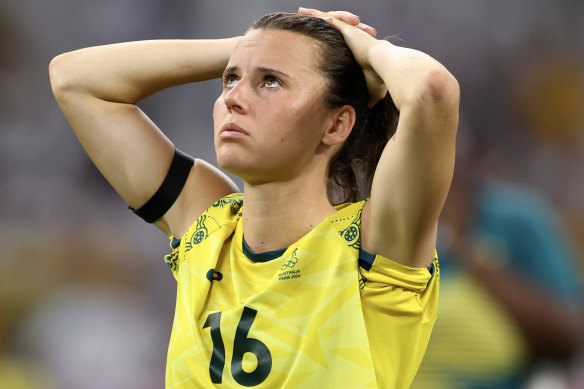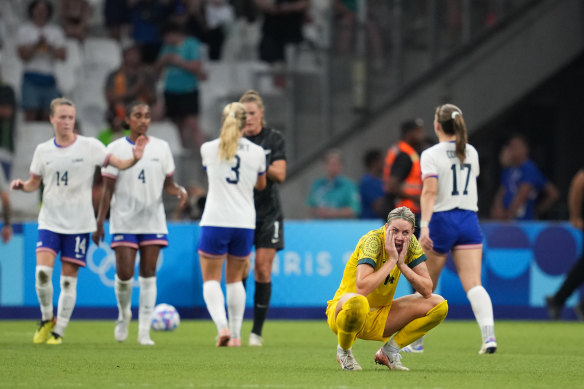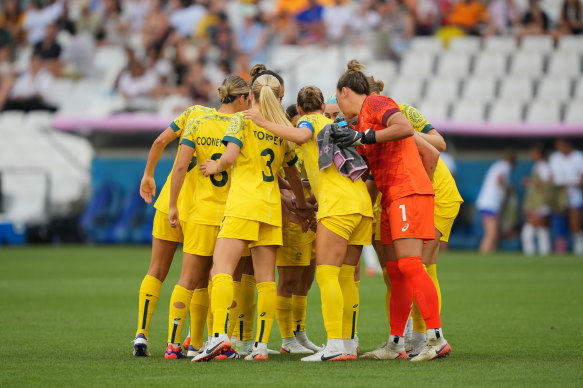- Analysis
- Sport
- Soccer
- Paris 2024
Where to from here? The questions the Matildas must answer
By Vince Rugari
And so the Tony Gustavsson era ends not with a bang, but with a whimper. It should not have been a surprise. Too many things were against the Matildas at these Olympics.
There was no Sam Kerr. There was not much from Caitlin Foord or Mary Fowler, the two most important attacking players besides Kerr, playing ill-defined roles in a team with no sense of cohesion, collectively off its game.
Too many dumb mistakes in defence. Too many injury clouds hovering over too many important players and too many others too short of a gallop. Possibly too much asked of them all at the pre-Games training camp in Marbella; too many miles in the legs. Too many lofty expectations weighing on them. Too much pampering, if you listen to some of the reductive and unhelpful nonsense going around, which obscures a much more important conversation.
Layer on top of all of that a difficult group and a coach whose tactics and selections have been questionable at the best of times, who had never managed to implement a discernible style of play over his four-year tenure, and it’s just too much going wrong at once.
Now comes the inevitable “worldwide search” by Football Australia to find a successor. It’s a massive task, and in some ways one of the most important appointments in the game’s history, across both male and female national teams.
The Matildas are as big as football has ever been in this country, and that means they are a cash machine for the federation, which has made tens of millions of dollars out of the buzz from their World Cup campaign last year and their staggering run of 14 consecutive sell-out matches at home. If they slide, as a football team, the brand suffers damage, too.

A distraught Hayley Raso at full-time against the United States.Credit: Getty
It is in everyone’s interest that this cash machine keeps on ka-ching-ing – including the players, who share in the spoils of their rise to fame through a revenue-sharing clause in their EBA, signed last year. And in that context, FA should spare no expense in their hunt for the next Matildas coach.
They are about to announce a new $200 million television deal with Ten and Paramount, and last week added Allianz to their suite of blue-chip sponsors seeking to bask in the team’s glory. They may have to spend money to continue making money. FA has enough of it to at least start sounding out the interest of the very best coaches in the world.
Not that there are many of them looking for a job at the moment, but this one, these days, requires someone with a level of gravitas to deal with the many internal and external pressures that come with it.
But before they whip out the chequebook and hit the phones, FA should take a second, breathe, and ask themselves some questions. And not just the obvious ones about what went wrong at Paris 2024, as their routine review should cover off.

Alanna Kennedy couldn’t hide her pain at the final whistle against the US.Credit: Getty Images
What kind of team do they want the Matildas to be? Are they OK with, as Gustavsson did, parking the bus against the United States in a game they had to at least draw to survive? Does that align with their “never-say-die” spirit? Can they not be more, as a team? What would that entail? Can we even do it, with the players we have? Who gets to decide these things? What criteria will guide whoever is spearheading the recruitment process, and how will it be drawn up?
Two years ago, the Socceroos stumbled badly during qualification for the World Cup in Qatar, and Graham Arnold’s head was on the chopping block. All these questions were asked then, as they have been many times prior: who, exactly, is in charge of Australia’s overall on-field direction? Who is looking at the bigger picture and pondering the big questions about identity? Who do the national team coaches answer to when things go wrong? And who does the person (or people) who selected the national team coach answer to in that instance?
FA’s response to the maelstrom back then was to install former A-League coach Ernie Merrick as chief football officer, aka the “disruptor”. We’d say he’s been doing a good job, but we don’t really know; he has barely spoken since taking on what should be the most important football job in the country. FA has still not released the new technical strategy it has been teasing since the start of the year, which he has been working on. If Merrick has had regularly conversations with Gustavsson about the way he is coaching, we are not aware of them. If Merrick isn’t holding him to account, who is?
This stuff matters, because without the right processes and structures, the national teams are left just hanging, their direction of travel dictated by whoever the coach happens to be at a given time.

The Matildas are facing a period of rebuilding.Credit: Getty
Soon, the well will run dry for the Matildas. This current squad is getting older, and many of the stars who have become household names during the past 18 months will probably sail off into the sunset after the 2026 Asian Cup.
Who will replace them? The youth national teams for women have never won any continental titles in Asia; the under-20s and under-17s have qualified for one World Cup between them in their last 15 attempts combined. As standards rise elsewhere, it will be increasingly difficult for the Matildas to even reach major tournaments like the Olympics; if it weren’t for the hosting rights, they wouldn’t have qualified directly for the last World Cup. FA does a lot right, but what are they doing about this?
The A-League Women’s competition is also at risk of atrophy as a result of the reduction in central distributions from the Australian Professional Leagues to $530,000 per season, which will inevitably lead to a decline in quality as established players and youngsters with ambitions chase a bigger payday in Europe or the USA. It’s already happening.
Some clubs would completely shutter their women’s team operations if they could avoid the fatal PR damage that would come with such a decision. They won’t say it publicly, but some clubs feel as if they are footing the bill for the development of future Matildas without reaping any of the benefits, which end up with FA, and would like them to chip in.
Is the women’s league just a talent ID mechanism now, run off the smell of an oily rag, farming out the best young players to overseas clubs as soon as they emerge? Is it even the right thing for women’s club football in Australia to be so tied directly to the men?
Would it be a net positive for the game if the women branched out on their own, like the US National Women’s Soccer League’s unaffiliated, standalone teams?
Big questions. For someone, somewhere to answer, at some point.
Sports news, results and expert commentary. Sign up for our Sport newsletter.
For Olympics news, results and expert analysis sent daily throughout the Games, sign up for our Sport newsletter.